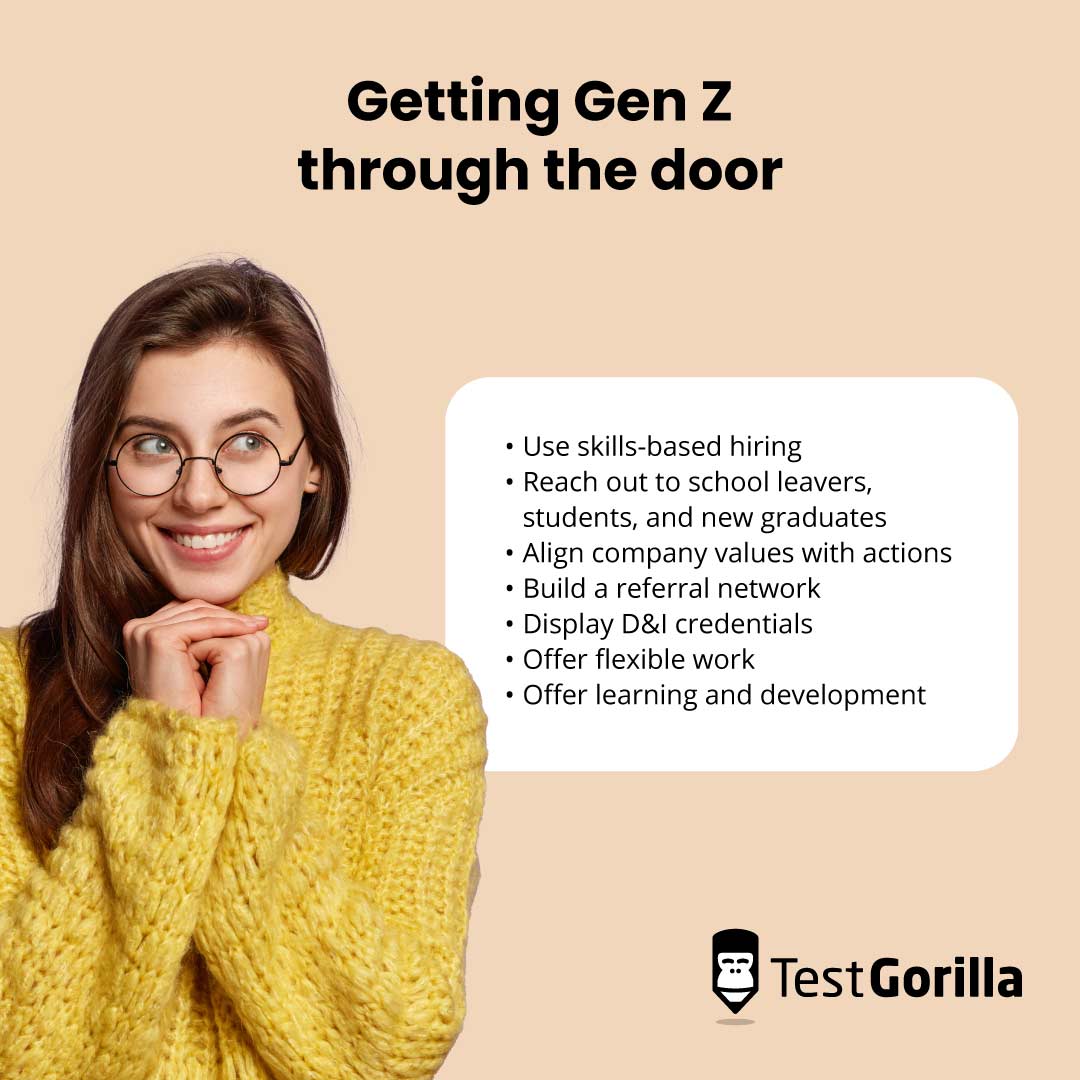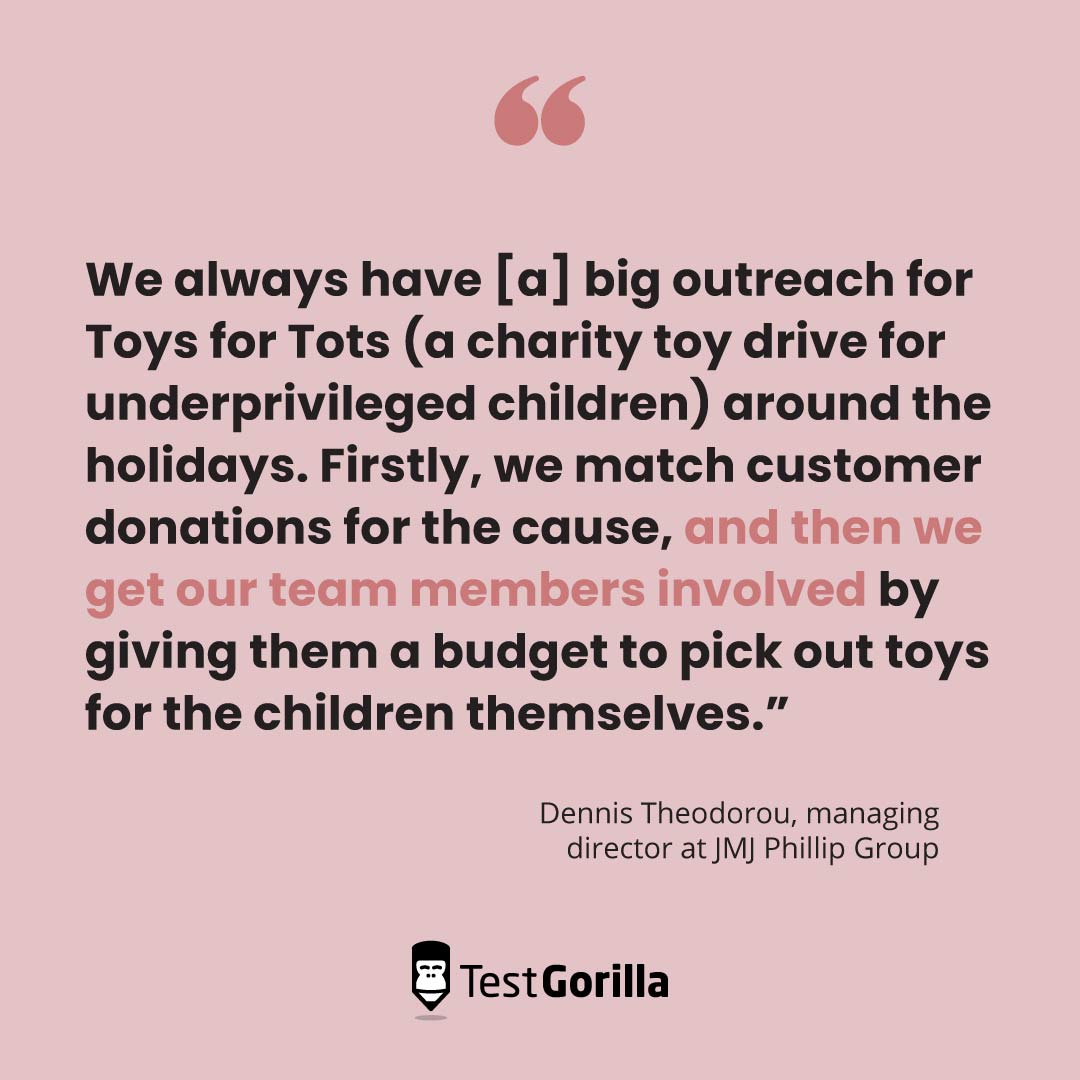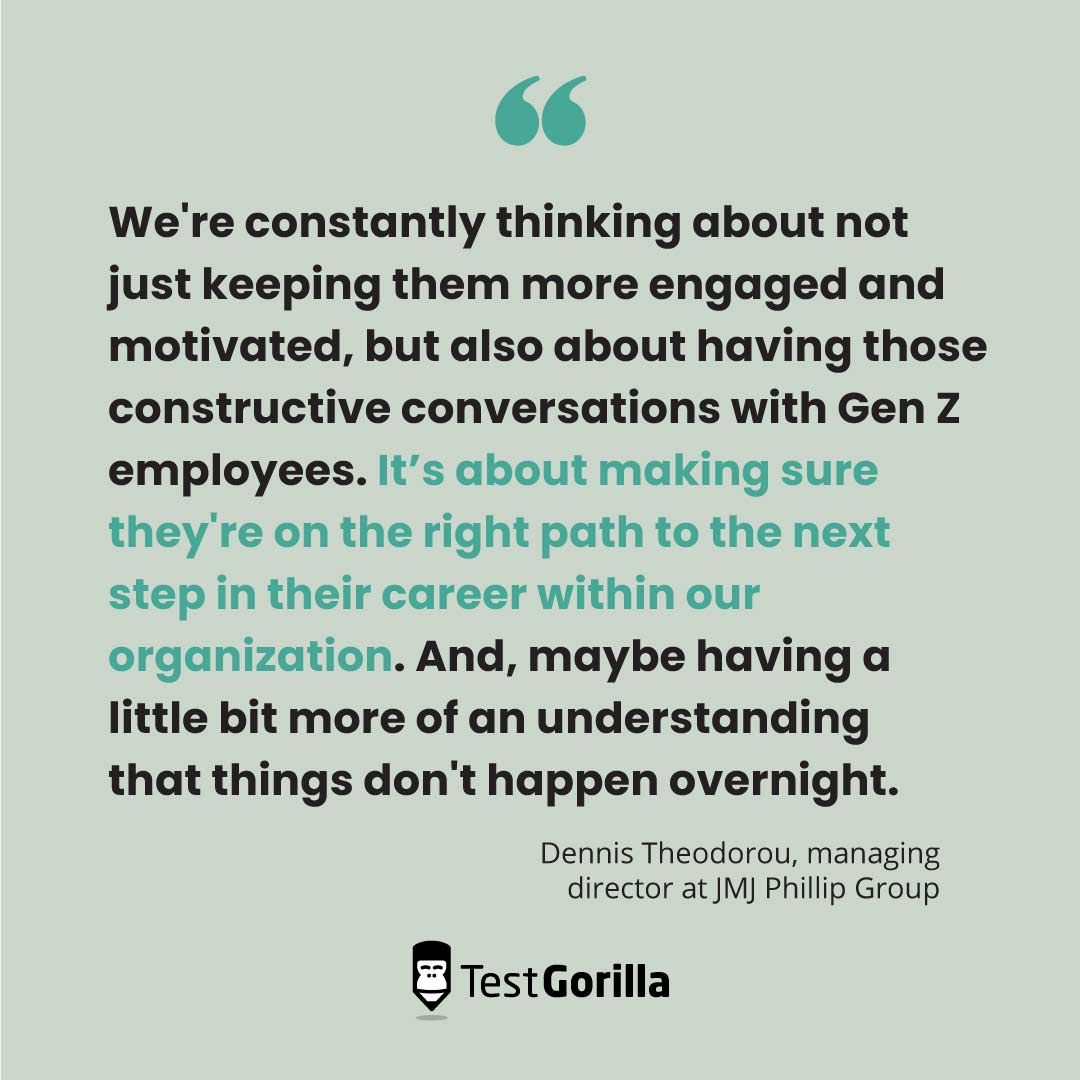Next generation hiring: Designing a recruitment process that gets Gen Z through the door
Standing out from the crowd can be difficult for Gen Zs who are new to the workplace. This generation has the highest unemployment rate and believes it’s harder than ever to enter the workforce.
Some young people can participate in unpaid internships for that all-important foot in the door, but not everyone can afford to work for free. As a result, many university-educated young people end up working low-skilled jobs while awaiting their big break.
In this article, we’ll explore how to design a hiring funnel to get the next generation of talent through your door by understanding what Gen Z values in the candidate and employee experience.
We’ll also look at how you can use skills-based hiring to give Gen Z a chance to succeed – an approach that will be popular with this group since 56% believe skills-based education and recruiting should go hand-in-hand.¹
Gen Z: A new kind of worker
Gen Zs account for 30% of the world population, and are expected to make up 27% of the global workforce by 2025.² They’re also the first generation to be fully immersed in tech: social media, the Internet, and smartphones are integral parts of their everyday life — and always have been.
Growing up with an abundance of information and a desire to upend the status quo, they’re a global, outspoken, and socially responsible group.³ Rather than follow in the footsteps of Millennial “resilience” at work, they’re calling for real support and genuine change.⁴
What might have inspired previous generations to apply for and accept jobs, as well as climb the corporate ladder, doesn’t necessarily work for younger workers. Millennial hiring, for example, will be very different from Gen Z hiring. To hire Gen Zs, you need an approach that targets them directly and caters to their aspirations.
For example, Gen Z appreciates occupational mobility and the ability to pivot more than other generations, with 58% wanting to leave their jobs within the next year.⁵ However, they’re more likely to stick around if company beliefs align with their own on issues like sustainability, diversity, and gender equality.⁴
This means it’s important to make sure you’re creating and maintaining a positive workplace culture that attracts Gen Zs.
7 ways to get Gen Z through the door
Companies with diverse teams are more likely to outperform less diverse ones. As the most diverse generation out there, by hiring Gen Z talent, you’re more likely to maintain a diverse and inclusive work culture. All of this helps create a virtuous cycle of attracting and retaining more Gen Zs, as well as transforming business outcomes by supporting diverse teams.
Here’s how you can adapt your recruiting strategy to support Gen Z while still getting the necessary skills for a role.
1. Use skills-based hiring
Skills-based hiring involves using skills assessments and take-home tasks to understand a candidate’s skills and competencies before they start interviewing. It helps save time interviewing candidates who don’t have the necessary skills. It also gives you access to talent in underserved communities as well as more diverse applicant pools.
This approach can get you in front of skilled through alternative routes (STAR) candidates who might have the skills to excel in the role, but lack a typical four-year college degree. This is especially important because 60% of the US workforce alone are STAR candidates, including 62% of African Americans, 55% of Hispanics, and 62% of veterans.⁷
Skills-based hiring also helps you attract Gen Z candidates because they prefer learning hands-on skills and developing them through on-the-job experiences. Nearly one-third of current teens prefer their post-high school education to last two years or less.¹ This can help bridge the digital divide and growing skills gap, and get more people working in high-skilled jobs.
Additionally, with the right talent assessment software, you can test for soft, hard, and transferable skills. You can also use tests like the Culture-add test, which demonstrates a candidate’s ability to add to company culture, not fold neatly into it. Tests like these are crucial because positive company culture is one of Gen Z’s top priorities at work.
2. Reach out to school leavers, students, and new graduates
In an interview with Dennis Theodorou, managing director at JMJ Phillip Group, he told us that, in his experience, it’s important to start reaching out to students and new graduates before they enter the workforce.
“If you’re interested in one of them as a potential employee, you need to keep them very engaged and things moving along. There’s so much opportunity for them to just click a button and apply to something else.”
This is especially true because, on top of the competition and war for talent, Gen Z requires more personalization and personal attention in advancing their career journey than previous generations.⁸ This includes face-to-face interactions with recruiters and participating in on-campus career fairs.
3. Align company values with actions
Make sure company values are clearly communicated on job advertisements and be proactive when supporting causes Gen Z care about, like gender equality or sustainability. It’s worth considering that 37% of Gen Zs have rejected a work-related assignment or job based on their personal beliefs.⁴
Communicating strong values is key to capturing and retaining Gen Z attention in a sea of companies expressing similar commitments. The difference is how you implement your values and whether you can motivate workers of all ages to get involved.
Dennis has an interesting solution when it comes to aligning company values with actions:
“We always have [a] big outreach for Toys for Tots (a charity toy drive for underprivileged children) around the holidays. Firstly, we match customer donations for the cause, and then we get our team members involved by giving them a budget to pick out toys for the children themselves.”
Essentially, you can combine philanthropy with team-building activities to act on company values and get your people engaged. You can also open it up to your team and company, and ask people to choose which charity or cause you’ll support next year.
4. Build a referral network
**Employee referrals are Gen Z’s favorite job source. In fact, over 60% of Gen Z rely on referral networks when looking for employment.**⁸ However, although popular, they’re not great for improving D&I, and it’s important to recruit talent outside of your immediate circles.
This means it’s important to build a diverse referral network that makes it easy for employees to refer potential candidates. Here’s how:
Use talent assessment software to determine if referrals can meet the expectations of the role, and have the necessary skill set before you interview them. This helps keep everyone involved and aware of the referred candidates’ progress.
Outline the guidelines, incentives, and rewards for participating employees. Make sure everything is easy to understand, transparent, and aligned with your company culture.
Communicate the program across teams and departments and clearly explain the benefits of participating, along with step-by-step instructions on how to refer candidates.
Educate employees on how to effectively refer candidates through training sessions or workshops. Help them understand the type of candidates you’re looking for and how to approach potential referrals. Provide them with resources such as referral templates, job descriptions, and relevant information about the company and open positions.
Incentivize employees with special perks like a free lunch of their choice or an extra vacation day.
Establish metrics to evaluate the success of your referral program and track the number of referrals received, the quality of hires, and the overall impact on your recruitment efforts.
5. Display D&I credentials
Ninety-nine percent of Gen Z consider D&I important.⁹ This includes matters related to race and gender, as well as identity and orientation. In fact, Gen Z’s level of satisfaction with a company’s commitment to D&I has a direct impact on job loyalty.⁴
To stand out to Gen Z candidates, it’s crucial to show your commitment to D&I in all its dimensions.
To do this:
Craft a D&I statement that articulates your company’s commitment to diversity and inclusion. It should align with your company’s values and be prominently displayed on your website, job postings, and other relevant platforms.
Create a dedicated D&I page on your website that highlights your organization’s D&I initiatives, programs, and policies.
Share diversity statistics and an employee distribution map on your website and job ads to highlight key workforce demographics. For example, the percentage of employees from different racial and ethnic backgrounds and cultures, gender diversity, representation at various levels, and any other relevant metrics.
Showcase community involvement by highlighting any partnerships or collaborations your organization has with external diversity organizations, community groups, or nonprofits.
6. Offer flexible work
Seventy-five percent of Gen Z professionals prefer remote or hybrid working environments.⁴
Therefore, it’s fair to say Gen Z values autonomy and wants a say in how they manage their time, commitments, and workload.
Here’s how you can spark interest in Gen Z when it comes to flexible working:
Offer flexible scheduling options like different start and end times as well as half days or shorter work weeks.
Enable employees with job-sharing opportunities to help keep diverse and skilled talent while letting them split the duties of a full-time role. This also helps support working mothers, new parents, older workers, and neurodiverse individuals.
Place emphasis on output and results over hours worked to help break the traditional narrative that hours logged equates to job loyalty and performance.
Let candidates choose their preferred working environment (remote or hybrid) on their job application if applicable.
7. Offer learning and development
In addition to a good work-life balance, learning and development opportunities are the second most important consideration for Gen Z when choosing a new job.⁴ To attract and recruit Gen Z, your commitment to developing your people and helping them achieve their aspirations needs to be front and center.
Remember: Gen Z learns best by doing as well as seeing complex concepts explained with visual support. They’re more social learners than previous generations, which means they prefer to learn through demonstration and collaboration rather than by sitting in a lecture.¹⁰
Here’s how you can offer reskilling and upskilling opportunities to Gen Z employees:
Offer opportunities for mentorship, job shadowing, and coaching, and encourage knowledge-sharing from more experienced employees.
Enable cross-functional collaboration and get people working with other departments and teams to spot opportunities for horizontal collaboration or mobility.
Use skills-based assessments to perform a company-wide or department-specific skills audit and identify areas for skills development.
Provide further learning resources like subscriptions to online journals, courses, certifications, and a list of important thinkers and influencers to follow.
According to Dennis, Gen Z is hungrier than previous generations when it comes to promotions and learning and development opportunities.
“We’re constantly thinking about not just keeping them more engaged and motivated, but also about having those constructive conversations with Gen Z employees. It’s about making sure they’re on the right path to the next step in their career within our organization. And, maybe having a little bit more of an understanding that things don’t happen overnight.”
The best insights on HR and recruitment, delivered to your inbox.
Biweekly updates. No spam. Unsubscribe any time.
Use skills-based hiring for multigenerational recruiting
Gen Z is the most racially diverse and best-educated generation but can struggle to get their foot in the door and stand out in job applications. Recruiting this group means paying attention to their specific needs, interests, and patterns – not simply using the same tactics that might’ve worked for generations before.
That’s why in this piece, we’ve outlined seven ways to recruit Gen Z by focusing on what this generation values most at work – a positive work culture, mental health, and meaningful work.
Strategies include: reaching out to students and new graduates, aligning company values with actions, building a referral network, and displaying D&I credentials. These can help you hire a multigenerational and diverse team that performs well.
By using a skills-based approach to hiring, companies can help support Gen Z candidates and level the playing field. This way, you can determine whether they have the right hard, soft, and transferable skills for your open role before they start.
You can also work with new hires to outline a development plan based on desired or in-demand skills – and grow with them.
Want an easier way to attract and retain skilled talent? Skills-based hiring helps you hire top candidates at any age or stage in their career. Download the State of Skills-based Hiring 2022 report to learn more.
Sources
“Report: Gen Z Teens Want Shorter, More Affordable, Career-Connected Education Pathways.” (2022). Question the Quo. Retrieved May 15th, 2023. https://www.questionthequo.org/news/buzz/report-gen-z-teens-want-shorter-more-affordable-career-connected-education-pathways
“Chart: How Gen Z employment levels compare in OECD countries.” (2021). World Economic Forum. Retrieved May 15th, 2023. https://www.weforum.org/agenda/2021/03/gen-z-unemployment-chart-global-comparisons/
“How Gen Zs Are Rebelling Against The Status Quo.” (2022). YouthSense. Retrieved May 22, 2023. https://youthsense.com.au/youth-insights/how-gen-zs-are-rebelling-against-status-quo/
“The Deloitte Global 2022 Gen Z and Millennial Survey.” (2022). Deloitte. Retrieved May 15th, 2023. https://www.deloitte.com/global/en/issues/work/genzmillennialsurvey.html
“Understanding Generation Z in the workplace.” (n.d.) Deloitte. Retrieved May 15th, 2023. https://www2.deloitte.com/us/en/pages/consumer-business/articles/understanding-generation-z-in-the-workplace.html
“Why Gen Z cares less about getting a 4-year college degree.” (2022). Fast Company. Retrieved May 15th, 2023. https://www.fastcompany.com/90755962/why-gen-z-cares-less-about-getting-a-4-year-college-degree
“Report: Reach for the STARs: Realizing the Potential of America’s Hidden Talent Pool.” (n.d.). Opportunity @ Work. Retrieved May 15, 2023. https://opportunityatwork.org/our-solutions/stars-insights/reach-stars-report/#get-report
“The 2019 Yello Recruiting Study: Meet Generation Z.” (2019). Yello. Retrieved May 16th, 2023. https://yello.co/resource/white-paper/generation-z-recruiting-study/
“What Companies Need To Know About Gen Z’s Diversity, Equity, and Inclusion Expectations.” (2021). Tallo. Retrieved May 16th, 2023. https://tallo.com/blog/gen-z-workplace-diversity-equity-inclusion/
“Report: Getting to Know Gen Z.” (2018) Barnes & Noble College. Retrieved May 22, 2023. https://partnerships.bncollege.com/wp-content/uploads/2018/03/Barnes-Noble-College-Gen-Z-Report.pdf
Related posts
You've scrolled this far
Why not try TestGorilla for free, and see what happens when you put skills first.

















